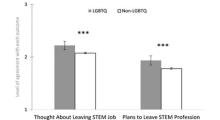
Photo credit: Sharon McCutcheon/Unsplash
June is Pride Month, an opportunity to celebrate the various perspectives and experiences of our sexual and gender minority (SGM) colleagues who enhance the mission of NIH. We should also recognize the persistent challenges SGM individuals in the scientific workforce encounter due to systemic inequalities compared to their non-SGM colleagues.
SGM populations include, but are not limited to, individuals who identify as lesbian, gay, bisexual, asexual, transgender, Two-Spirit, queer, and/or intersex. Individuals with same-sex or -gender attractions or behaviors and those with a difference in sex development are also included. These populations also encompass those who do not self-identify with one of these terms but whose sexual orientation, gender identity or expression, or reproductive development is characterized by non-binary constructs of sexual orientation, gender, and/or sex.
The NIH uses the term SGM to be fully inclusive of these diverse populations. In this post, I also use lesbian, gay, bisexual, transgender, and queer (LGBTQ) when referring to studies that reflect differences in how researchers defined their samples.
Experiences of SGM Scientists
Scientists who are LGBTQ are more likely to experience harassment and career obstacles than their heterosexual and cisgender counterparts, according to a 2021 survey of over 25,000 scientists, including 1,006 who self-identified as LGBTQ.
As I described in our January 2021 Scientific Workforce Diversity newsletter, this survey found LGBTQ professionals were statistically more likely to report limited career opportunities, social marginalization and harassment, and devaluation of professional expertise by colleagues. The LGBTQ respondents were also less likely to be comfortable with the whistleblowing process and more likely to leave STEM careers (Figure 1).

Figure 1. Intentions to leave STEM by LGBTQ status. (Source: https://advances.sciencemag.org/content/7/3/eabe0933)
The survey findings are similar to trends observed at six U.S. STEM-related federal agencies and findings from the 2019 NIH Workplace Climate and Harassment Survey. The NIH survey results indicate that individuals who reported having a gender identity other than man or woman, and respondents who identified as bisexual, were more likely to have experienced sexual harassment during the 12 months prior to the survey (Figure 2).
Percentage of Each Vulnerable Group Experiencing Sexual Harassment in the Past 12 Months

Figure 2. Percentage of Each Vulnerable Group Experiencing Sexual Harassment in the Past 12 Months (Source: NIH Workplace Climate and Harassment Survey https://diversity.nih.gov/sites/coswd/files/images/docs/NIH_Workplace_Climate_and_Harassment_Survey_Executive_Report_508.pdf)
Unwelcoming workplaces mean more than 40 percent of LGBTQ professionals in STEM are not publicly “out” about their sexual orientation and/or gender identity to their colleagues, according to results from a 2013 survey. And most survey respondents could not name a single LGBTQ faculty member at the universities where they got their degrees.
The findings suggest a lack of visible representation of SGM role models and mentors for SGM professionals, which may adversely impact careers in science.
Institutional support and policies matter, too. The 2013 survey found SGM scientists are less likely to be out at institutions that do not offer same-sex partner benefits or support name changes during a gender transition.
Advancing SGM Inclusion and Retention
Diversity and inclusion efforts must be supportive and inclusive of all underrepresented groups, including SGM scientists. Despite changing attitudes and progress, the biomedical community needs to do more to address the discrimination and disadvantages SGM individuals face in the scientific workforce and create a welcoming culture. Successful interventions that foster recruitment, retention, and advancement opportunities for SGM scientists include:
- Reversing exclusive policies
- Countering implicit bias
- Facilitating mentoring opportunities
- Supporting visibility initiatives
- Educating their peers about how to be allies and advocates
Research shows that diverse teams encourage greater innovation and creativity because they bring different perspectives to a problem—and we must work to ensure that science contains the voices of SGM scientists. Including a full range of unique and diverse perspectives within the scientific workforce sends the message that all are welcome here.
Upcoming Learning Opportunities at NIH
The NIH Office of Equity, Diversity, and Inclusion (EDI) is celebrating Pride Month with the theme Allyship in Action as one of several ways to demonstrate support for our SGM colleagues. EDI will host two webinars on Wednesday, June 23, in celebration of Pride: “Barriers for LGBTQ Scientists” at 1:00 p.m. ET and “A Sexual and Gender Minorities Panel: What Brings Us Here - Experiences and Perspectives from Across the NIH” at 3:00 p.m. ET.
In July, a post on this blog will feature an interview with Dr. Karen Parker, Director of the NIH Sexual and Gender Minority Research Office (SGMRO). She’ll discuss SGMRO’s work, the NIH FY 2021–2025 Strategic Plan to Advance Research on the Health and Well-being of Sexual and Gender Minorities, and efforts of the NIH Sexual & Gender Minority Research Coordinating Committee and the NIH Council of Councils Sexual & Gender Minority Research Working Group.
Dr. Bernard’s Parting Thoughts
The NIH Scientific Workforce Diversity office celebrates and supports diversity in all its forms. We are committed to creating an inclusive scientific workforce where SGM scientists feel welcome and safe and can flourish in their careers. By reducing their barriers to entry and broadening their participation in biomedical science, we ensure a full range of perspectives inform and drive innovation in the field.

